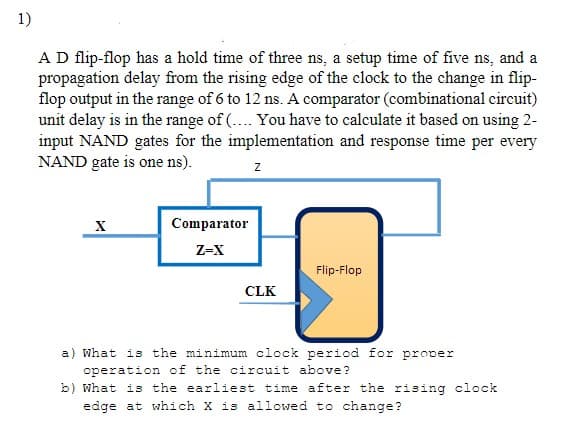A D flip-flop has a hold time of three ns, a setup time of five ns, and a propagation delay from the rising edge of the clock to the change in flip- flop output in the range of 6 to 12 ns. A comparator (combinational circuit) unit delay is in the range of (.... You have to calculate it based on using 2- input NAND gates for the implementation and response time per every NAND gate is one ns). X Comparator Z-X Z CLK Flip-Flop a) What is the minimum clock period for prover operation of the circuit above? b) What is the earliest time after the rising clock edge at which X is allowed to change?
A D flip-flop has a hold time of three ns, a setup time of five ns, and a propagation delay from the rising edge of the clock to the change in flip- flop output in the range of 6 to 12 ns. A comparator (combinational circuit) unit delay is in the range of (.... You have to calculate it based on using 2- input NAND gates for the implementation and response time per every NAND gate is one ns). X Comparator Z-X Z CLK Flip-Flop a) What is the minimum clock period for prover operation of the circuit above? b) What is the earliest time after the rising clock edge at which X is allowed to change?
Computer Networking: A Top-Down Approach (7th Edition)
7th Edition
ISBN:9780133594140
Author:James Kurose, Keith Ross
Publisher:James Kurose, Keith Ross
Chapter1: Computer Networks And The Internet
Section: Chapter Questions
Problem R1RQ: What is the difference between a host and an end system? List several different types of end...
Related questions
Question
I need help with a clear explanation, please

Transcribed Image Text:1)
A D flip-flop has a hold time of three ns, a setup time of five ns, and a
propagation delay from the rising edge of the clock to the change in flip-
flop output in the range of 6 to 12 ns. A comparator (combinational circuit)
unit delay is in the range of (.... You have to calculate it based on using 2-
input NAND gates for the implementation and response time per every
NAND gate is one ns).
X
Z
Comparator
Z-X
20
Flip-Flop
CLK
a) What is the minimum clock period for prover
operation of the circuit above?
b) What is the earliest time after the rising clock
edge at which X is allowed to change?
Expert Solution
This question has been solved!
Explore an expertly crafted, step-by-step solution for a thorough understanding of key concepts.
This is a popular solution!
Trending now
This is a popular solution!
Step by step
Solved in 4 steps with 3 images

Recommended textbooks for you

Computer Networking: A Top-Down Approach (7th Edi…
Computer Engineering
ISBN:
9780133594140
Author:
James Kurose, Keith Ross
Publisher:
PEARSON

Computer Organization and Design MIPS Edition, Fi…
Computer Engineering
ISBN:
9780124077263
Author:
David A. Patterson, John L. Hennessy
Publisher:
Elsevier Science

Network+ Guide to Networks (MindTap Course List)
Computer Engineering
ISBN:
9781337569330
Author:
Jill West, Tamara Dean, Jean Andrews
Publisher:
Cengage Learning

Computer Networking: A Top-Down Approach (7th Edi…
Computer Engineering
ISBN:
9780133594140
Author:
James Kurose, Keith Ross
Publisher:
PEARSON

Computer Organization and Design MIPS Edition, Fi…
Computer Engineering
ISBN:
9780124077263
Author:
David A. Patterson, John L. Hennessy
Publisher:
Elsevier Science

Network+ Guide to Networks (MindTap Course List)
Computer Engineering
ISBN:
9781337569330
Author:
Jill West, Tamara Dean, Jean Andrews
Publisher:
Cengage Learning

Concepts of Database Management
Computer Engineering
ISBN:
9781337093422
Author:
Joy L. Starks, Philip J. Pratt, Mary Z. Last
Publisher:
Cengage Learning

Prelude to Programming
Computer Engineering
ISBN:
9780133750423
Author:
VENIT, Stewart
Publisher:
Pearson Education

Sc Business Data Communications and Networking, T…
Computer Engineering
ISBN:
9781119368830
Author:
FITZGERALD
Publisher:
WILEY